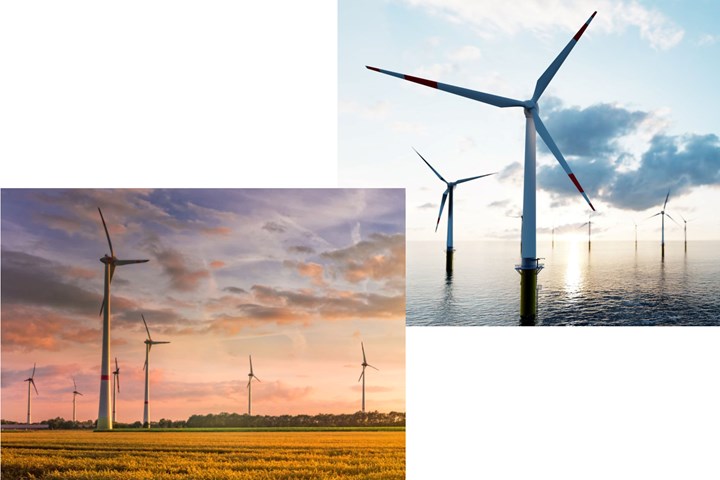North Sea countries target 260 GW of offshore wind energy; onshore wind shows reduced CO2 in U.S.
Nine EU countries agree to increased installations by 2050 for reduced CO2, a goal proven by a U.S. energy report, citing highest reductions in wind belt states.
Share

As reported by North American Windpower, energy ministers from the nine members of the North Seas Energy Cooperation (includes Belgium, Denmark, France, Germany, Ireland, Luxembourg, the Netherlands, Norway, Sweden and the European Commission; the U.K. withdrew in January 2020) agreed to increase offshore wind deployment at their recent meeting in Dublin, Ireland. The new goal of at least 260 GW of offshore wind energy by 2050 will represent more than 85% of the EU-wide 2050 target of 300 GW.
“The green energy transition has only become more urgent since Russia’s invasion of Ukraine,” says Commissioner for Energy Kadri Simson. “The acceleration of renewables deployment is one of the three pillars of the REPowerEU Plan to end our dependence on Russian fossil fuels. Increasing renewable energy will not only help to improve the sustainability of our energy sector, it will improve our security of supply and the affordability of energy — two challenges that we are facing in the EU at the moment.”
“In Ireland alone, our sea area is seven times our landmass,” states Minister for the Environment, Climate and Communications Eamon Ryan. “The North Atlantic and North Sea comprise some of the windiest locations on the globe. It is our greatest collective resource of continuous energy, and it is momentous that we have agreed today to be ambitious in our targets, as a collective.” He noted the best way to realize that potential of offshore wind is to set agreed targets and operate as a collective. “With this approach, we can provide assurances to householders and businesses — in our own countries and across Europe — that firstly, Europe will be energy independent, and secondly, that these new renewable energy sources and resultant hydrogen from our seas will be fairly shared and, critically, will be affordable,” says Ryan.
North American Windpower also published highlights from the latest report by the U.S. Energy Information Administration (EIA), noting the carbon intensity of U.S. power generation fell 18% between 2016 to 2020, driven by a shift in the U.S. electricity generation mix away from coal and toward natural gas and renewables. The carbon intensity of power generation measures the amount of CO2 emitted to produce a unit of electricity. All but seven U.S. states decreased carbon intensity over that five-year period, although the amount varied state by state.
In 2020, the carbon intensity of U.S. power generation averaged 854 pounds of CO2/MWh, based on a carbon intensity of coal in the United States of 2,274 pounds of CO2/MWh, natural gas at 980 pounds of CO2/MWh and little to no emissions from nuclear, hydroelectric, wind and solar. The states with the lowest carbon intensities of power generation either have a large share of generation from renewables or a large combined share from renewables and nuclear. In 2020, Vermont had the lowest carbon intensity of power generation at 8.4 pounds of CO2/MWh, with almost all of its in-state electricity generation from renewables, but 60% sourced from Canada.
The five states with the largest reductions in carbon intensity between 2016 and 2020 (in pounds of CO2/MWh) were Tennessee (486), Maryland (477), Iowa (443), Kansas (371) and Oklahoma (348). Notably, the last three are located within the U.S. central wind belt.
Related Content
Infinite Composites: Type V tanks for space, hydrogen, automotive and more
After a decade of proving its linerless, weight-saving composite tanks with NASA and more than 30 aerospace companies, this CryoSphere pioneer is scaling for growth in commercial space and sustainable transportation on Earth.
Read MoreRecycling end-of-life composite parts: New methods, markets
From infrastructure solutions to consumer products, Polish recycler Anmet and Netherlands-based researchers are developing new methods for repurposing wind turbine blades and other composite parts.
Read MoreDrag-based wind turbine design for higher energy capture
Claiming significantly higher power generation capacity than traditional blades, Xenecore aims to scale up its current monocoque, fan-shaped wind blades, made via compression molded carbon fiber/epoxy with I-beam ribs and microsphere structural foam.
Read MoreComposites end markets: Energy (2024)
Composites are used widely in oil/gas, wind and other renewable energy applications. Despite market challenges, growth potential and innovation for composites continue.
Read MoreRead Next
Plant tour: Daher Shap’in TechCenter and composites production plant, Saint-Aignan-de-Grandlieu, France
Co-located R&D and production advance OOA thermosets, thermoplastics, welding, recycling and digital technologies for faster processing and certification of lighter, more sustainable composites.
Read MoreAll-recycled, needle-punched nonwoven CFRP slashes carbon footprint of Formula 2 seat
Dallara and Tenowo collaborate to produce a race-ready Formula 2 seat using recycled carbon fiber, reducing CO2 emissions by 97.5% compared to virgin materials.
Read MoreVIDEO: High-volume processing for fiberglass components
Cannon Ergos, a company specializing in high-ton presses and equipment for composites fabrication and plastics processing, displayed automotive and industrial components at CAMX 2024.
Read More














.jpg;maxWidth=300;quality=90)








